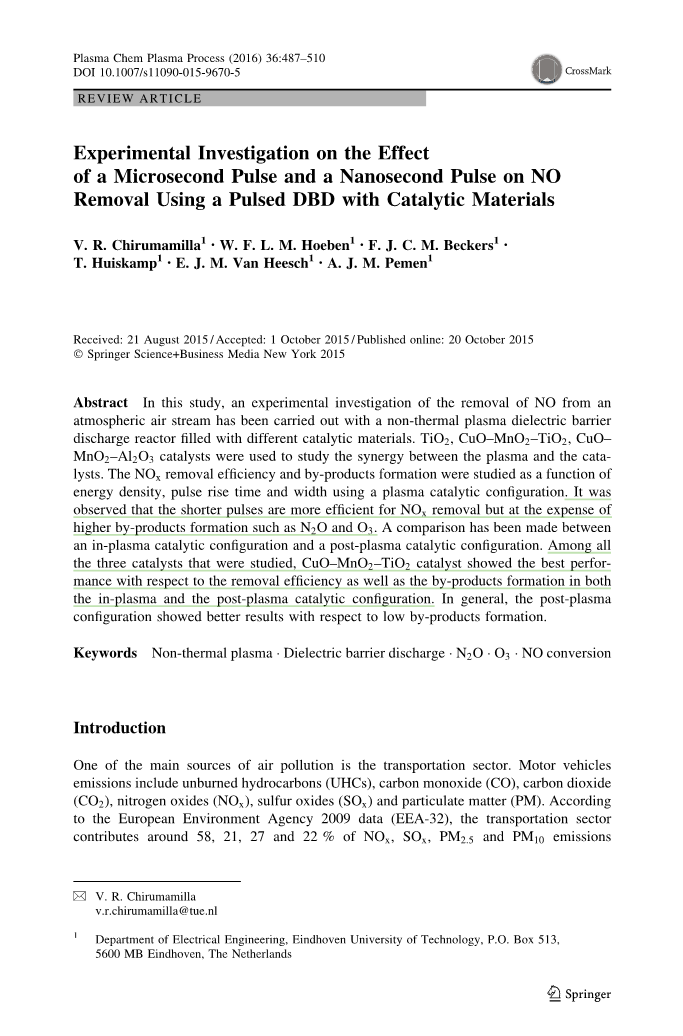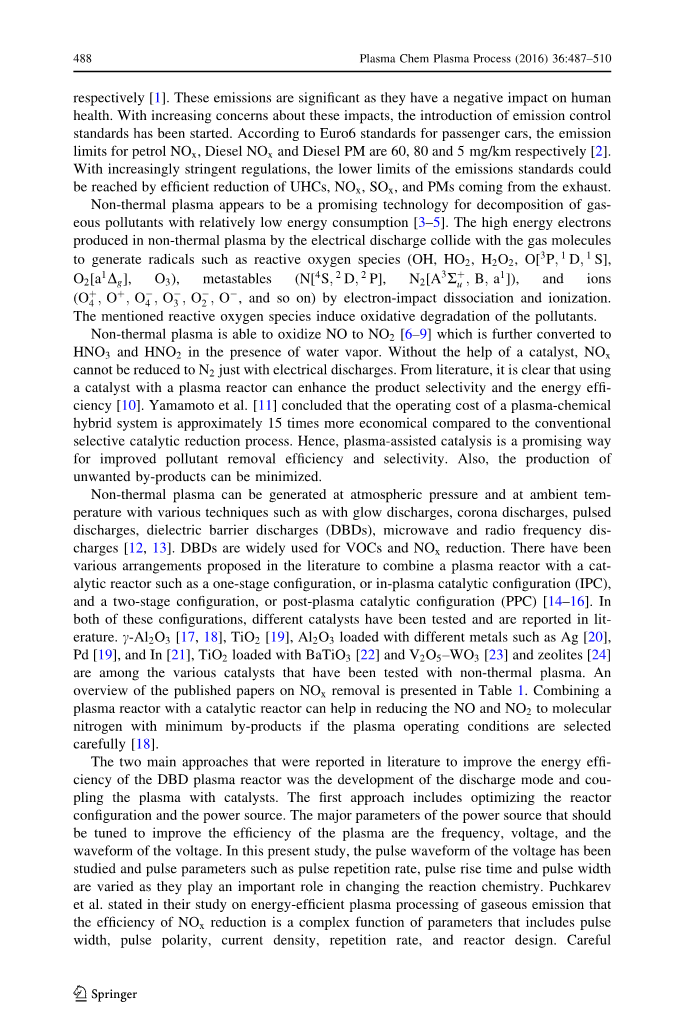介质阻挡放电反应器结构及电源参数优化试验研究
V. R. Chirumamilla1 bull; W. F. L. M. Hoeben1 bull; F. J. C. M. Beckers1 bull; T. Huiskamp1 bull; E. J. M. Van Heesch1 bull; A. J. M. Pemen1
摘要:在本次研究中,我们采用非热等离子体介质阻挡放电反应器,使用不同的催化材料对大气气流NO的去除进行实验研究。利用TiO2、CuO - mno2 - TiO2、CuO - MnO2-Al2O3催化剂研究了等离子体与cata-lysts之间的协同作用。利用等离子体催化结构,研究了NOx去除效率和副产物形成的能量密度、脉冲上升时间和宽度的函数。观察到,短脉冲对NOx去除效率更高,但代价是N2O和O3等副产物生成较高。在等离子体催化结构和后等离子体催化结构之间进行了比较。在研究的三种催化剂中,CuO-MnO2-TiO2催化剂的去除效果最好,在等离子体和后等离子体的催化配置中,都表现出了对去除效率和副产物形成的最佳效果。一般情况下,后等离子体构型对低副产物的形成有较好的结果
Experimental Investigation on the Effect of a Microsecond Pulse and a Nanosecond Pulse on NO Removal Using a Pulsed DBD with Catalytic Materials
Abstract In this study, an experimental investigation of the removal of NO from an atmospheric air stream has been carried out with a non-thermal plasma dielectric barrier discharge reactor filled with different catalytic materials. TiO2, CuO–MnO2–TiO2, CuO– MnO2–Al2O3 catalysts were used to study the synergy between the plasma and the cata-lysts. The NOx removal efficiency and by-products formation were studied as a function of energy density, pulse rise time and width using a plasma catalytic configuration. It was observed that the shorter pulses are more efficient for NOx removal but at the expense of higher by-products formation such as N2O and O3. A comparison has been made between an in-plasma catalytic configuration and a post-plasma catalytic configuration. Among all the three catalysts that were studied, CuO–MnO2–TiO2 catalyst showed the best perfor-mance with respect to the removal efficiency as well as the by-products formation in both the in-plasma and the post-plasma catalytic configuration. In general, the post-plasma configuration showed better results with respect to low by-products formation.
Keywords Non-thermal plasma Dielectric barrier discharge N2O O3 NO conversion
交通部门是空气污染的主要来源之一。汽车排放物包括未燃碳氢化合物(UHCs),一氧化碳(CO),二氧化碳(CO2),氮氧化物(NOx),硫氧化物(SOx)和颗粒物质(PM)。根据欧洲环境署2009年的数据(EEA-32),交通运输部门贡献了NOx,SOx,PM2:5和PM10排放量的58%,21%,27%和22%
分别[1]。这些排放量很重要,因为它们对人体健康有负面影响。随着对这些影响的担忧日益增加,排放控制标准的出台已经开始。根据乘用车Euro6标准,汽油NOx,柴油机NOx和柴油机PM的排放限值分别为60,80和5 mg / km [2]。随着法规越来越严格,排放标准的下限可以通过有效减少来自排气的UHC,NOx,SOx和PM来实现。
非热等离子体似乎是一种很有前途的技术,用于能量消耗相对较低的气体污染物的分解[3-5]。通过放电在非热等离子体中产生的高能电子与气体分子碰撞产生自由基,例如活性氧(OH,HO2,H2O2,O [3P; 1D; 1S],O2 [a1Dg], O3),亚稳态(N [4S; 2D; 2P],N2 [A3Rthorn;u; B; a1])和离子(O 4; O ; O4; O3; O2; O等)和电离。所提到的活性氧物质引起污染物的氧化降解。
非热等离子体能够将NO氧化成NO2 [6-9],在水蒸气存在下进一步转化为HNO3和HNO2。没有催化剂的帮助,只有放电才能将NOx还原成N2。从文献中可以清楚地看出,在等离子体反应器中使用催化剂可以提高产物选择性和能量效率[10]。 Yamamoto等人[11]得出结论认为,等离子体 - 化学混合系统的运行成本比传统的选择性催化还原工艺的成本低15倍左右。因此,等离子体辅助催化是提高污染物去除效率和选择性的有前途的方法。而且,不需要的副产品的产生可以被最小化。
|
Reactor configuration |
Conditions |
Catalyst |
Conversion |
Energy |
Application |
Refs. |
|
density |
||||||
|
DBD |
T: 773 K |
Indium doped: Al2O3 |
Approx. 60 % @ |
700 J/L |
Diesel engines |
[21] |
|
473 K |
||||||
|
V: 3–16 kV |
[ 90 % @ 623 K |
100 J/L |
||||
|
Addition of primary alcohols |
[ 80 % @ 773 K |
100 J/L |
||||
|
Cylindrical DBD |
Initial NO conc: 1000 ppm |
Ag/USY |
[28] |
|||
|
V: 5 kV with 50 Hz power input |
Ag/Al2O3 |
|||||
|
GHSV: 14,400 h 1 |
||||||
|
SDBD |
Wet gas |
c-Al2O3 |
Approx 60 % |
133 J/L |
Automobiles |
[17] |
|
Initial NO conc: 100 ppm |
||||||
|
Packed DBD |
60 Hz AC power supply |
BaTiO3 |
Approx 96 % |
55.5 J/L |
Flue gas emissions |
[18] |
|
Initial NO conc: 200 ppm |
||||||
|
Packed DBD (pulsed |
Initial NO conc: 300–500 ppm |
c-Al2O3 |
Approx 66 % |
140 J/L |
Exhaust gases |
[22] |
|
corona) |
NO2: 15–50 ppm |
BaTiO3 ? c-Al2O3 (1:5 |
60 % |
140 J/L |
||
|
ratio) |
||||||
|
Frequency: 300–350 pulses/sec |
c-Al2O3 ? TiO2 (1:1 ratio) |
21 % |
140 J/L |
|||
|
Addition of methanol as additive |
Co-ZSM-5 post-plasma |
78 % |
60 J/L |
|||
|
(1000 ppm) |
||||||
|
T: 150 C |
||||||
|
Packed DBD |
Initial NO conc: 570 ppm |
TiO2 coated glass beads |
Exhaust gases |
[29] |
||
|
Frequency: 900 全文共13199字,剩余内容已隐藏,支付完成后下载完整资料
英语原文共 24 页,剩余内容已隐藏,支付完成后下载完整资料 资料编号:[14588],资料为PDF文档或Word文档,PDF文档可免费转换为Word |




